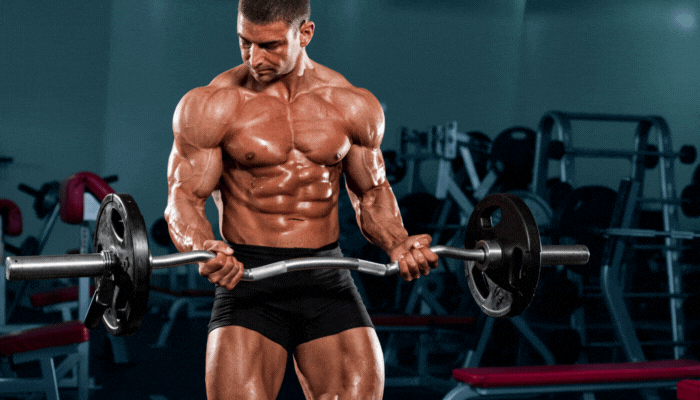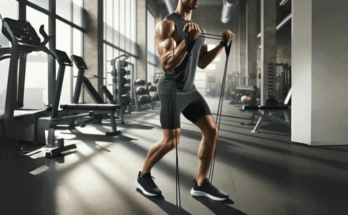Dumbbell High Curl
The dumbbell high curl is a strength training exercise that targets the biceps brachii, the muscle on the front of the upper arm. It is a compound exercise, meaning that it works multiple muscle groups at the same time. The dumbbell high curl is a good exercise for building strength and muscle mass in the biceps.

How to do It:
- Stand up straight with your feet shoulder-width apart.
- Hold a dumbbell in each hand with your palms facing your body.
- Curl the dumbbells up towards your shoulders, keeping your elbows close to your sides.
- Lower the dumbbells back down to the starting position.
Benefits:
- Builds strength and muscle mass in the biceps
- Improves grip strength
- Can help to improve posture
- Can help to reduce the risk of injury
Muscles worked:
- Biceps brachii (primary)
- Brachialis (secondary)
- Brachioradialis (secondary)
Brachialis Pull-Up
The brachialis pull-up is a variation of the traditional pull-up that specifically targets the brachialis muscle, the deep muscle of the biceps brachii. It is a compound exercise that works multiple muscle groups at the same time, including the biceps brachii, brachialis, brachioradialis, latissimus dorsi, and trapezius. The brachialis pull-up is a good exercise for building strength and muscle mass in the biceps and forearms.

How to do It:
- Before attempting brachialis pull-ups, perform a thorough warm-up to prepare your muscles and joints for the exercise. This could include light cardio, arm circles, and dynamic stretches.
- Stand under a pull-up bar with your hands shoulder-width apart, palms facing away from you. This grip places more emphasis on the brachialis muscle compared to a wider grip.
- Start by hanging from the bar with your arms fully extended and your body in a straight line from head to toe. Keep your core engaged to maintain a stable posture.
- Pull yourself up towards the bar, focusing on using your biceps brachii and brachialis muscles to flex your elbows. Keep your elbows close to your body throughout the movement.
- Aim to pull yourself up until your chin is above the bar. This will provide a full range of motion and maximize the activation of your brachialis muscle.
- Controlled descent: Slowly lower yourself back down to the starting position, maintaining control throughout the movement. Avoid swinging or using momentum.
Benefits:
- Targets the brachialis muscle, the deep muscle of the biceps brachii, contributing to a more defined bicep peak
- Engages multiple muscle groups, including the biceps brachii, brachialis, brachioradialis, latissimus dorsi, and trapezius, promoting overall upper body strength
- Enhances grip strength, beneficial for various activities and exercises
- Improves forearm strength and stability, supporting activities like rock climbing and gymnastics
Muscles worked:
- Primary: Brachialis, Biceps brachii, Brachioradialis
- Secondary: Latissimus dorsi, Trapezius, Rhomboids, Erector spinae
Close Grip Z-Bar Curl
The close-grip EZ-bar curl is a variation of the bicep curl that places a greater emphasis on the inner head of the biceps brachii muscle. It is a compound exercise that also works the brachialis and brachioradialis muscles. The close-grip EZ-bar curl is a good exercise for building strength and muscle mass in the biceps.

How to do It:
- Stand with your feet shoulder-width apart and hold an EZ-bar with a close grip, hands shoulder-width apart.
- Curl the bar towards your shoulders, keeping your elbows close to your sides.
- Slowly lower the bar back to the starting position.
Benefits:
- Targets the inner head of the biceps brachii, contributing to a more defined bicep shape
- Engages multiple muscle groups, including the biceps brachii, brachialis, and brachioradialis
- Enhances grip strength, beneficial for various activities and exercises
- Promotes overall upper body strength and development
Muscles worked:
- Primary: Biceps brachii (inner head), Brachialis, Brachioradialis
- Secondary: Forearms, Trapezius
Dumbbell Scott Curls
The dumbbell Scott curl is a biceps isolation exercise that targets the inner head of the biceps brachii muscle. It is a variation of the preacher curl, but instead of using a barbell, you use dumbbells. This allows you to keep your elbows close to your body throughout the movement, which helps to isolate the biceps muscles.

How to do It:
- Adjust an incline bench to a 30-45 degree angle. Sit on the bench with your back firmly against the pad. Hold a dumbbell in each hand, palms facing down and hands slightly wider than shoulder-width apart.
- Rest your upper arms on the padded support of the incline bench, keeping your elbows close to your body and wrists straight. Your elbows should be positioned slightly behind your body.
- Maintaining a neutral spine and keeping your elbows stationary, curl the dumbbells towards your chest, focusing on contracting your biceps brachii muscles.
- At the top of the movement, your forearms should be fully flexed, and the dumbbells should be close to your shoulders. Maintain this peak contraction for a moment.
- Slowly reverse the movement, lowering the dumbbells back down to the starting position. Control the descent and avoid using momentum.
Benefits:
- Dumbbell Scott curls effectively isolate the biceps brachii muscle, particularly the inner head, which contributes to a more defined bicep peak.
- The exercise strengthens the forearms and grip muscles, enhancing overall hand strength and control.
- Regularly performing dumbbell Scott curls can improve overall bicep function, leading to better performance in various activities and exercises.
- Dumbbell Scott curls help maintain muscle balance and symmetry in the upper arms, promoting a more aesthetically pleasing physique.
Muscles worked:
- Primary: Biceps brachii (inner head)
- Secondary: Brachialis, Brachioradialis, Forearms
Barbell Curls on an Arm Blaster
Barbell curls on an arm blaster are an effective exercise for isolating and strengthening the biceps brachii muscles, particularly the inner head, which contributes to a more defined bicep peak. The arm blaster helps to keep your elbows close to your body throughout the movement, which further isolates the biceps muscles and prevents you from using momentum to lift the weight. This can lead to increased muscle growth and improved grip strength.

How to do It:
- Secure the arm blaster around your upper arms, ensuring the pads rest comfortably on your triceps. Stand with your feet shoulder-width apart, holding the barbell with an overhand grip, hands slightly wider than shoulder-width apart.
- Keep your elbows close to your sides, resting against the arm blaster pads. Your torso should be upright, with a slight natural arch in your lower back. Avoid hunching forward or rounding your shoulders.
- Maintaining a neutral spine, curl the barbell upwards towards your chest, focusing on contracting your biceps brachii muscles. Keep your elbows stationary and avoid swinging your body.
- Hold the barbell at the top of the movement for a second, squeezing your biceps muscles tightly. Your forearms should be fully flexed, and the barbell should be close to your shoulders.
- Slowly reverse the movement, lowering the barbell back down to the starting position. Control the descent and avoid using momentum.
Benefits:
- The arm blaster effectively isolates the biceps brachii muscles, particularly the inner head, promoting a more defined bicep peak.
- Barbell curls engage the forearms and grip muscles, enhancing overall hand strength and control.
- The arm blaster restricts body movement, forcing you to focus on contracting your biceps for a more intense contraction.
- Regular practice of barbell curls on an arm blaster can improve muscle balance and symmetry in the upper arms, contributing to a more aesthetically pleasing physique.
Muscles worked:
- Primary: Biceps brachii (both heads)
- Secondary: Brachialis, Brachioradialis, Forearms



